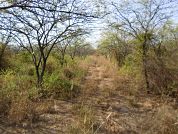The role of Science in land use planning (and in some other issues related to environmental problems)
DOI:
https://doi.org/10.25260/EA.16.26.2.0.189Abstract
The technical, political and administrative aspects of Rural Land Planning are closely linked and hardly can be treated in isolation. To incorporate science and scientists in land planning improves some factors that define the quality of the process (e.g. access to information, perception of problems, etc.) but not others (disputes on values and interests or power asymmetries). Science incorporates, as systematized knowledge, an indispensable “knowledge bank”. In turn, Science can play another key role in providing pa�erns of thought and action in which the criteria of truth are associated with empirical and logical evidence and not to the principle of authority or magical thinking. Society and the System of Science and Technology (SCyT) should identify those cases where participation is critical to avoid uninformed debates. The involvement of Science and scientists is important when you have to reduce the uncertainty associated with decision making. Should be avoided, meanwhile, the least recognized situation to force the participation of the SCyT in the cases of disputes over interests and values. In such situations its participation becomes unnecessary and possibly counterproductive. The participation of scientists has to happen in close collaboration with other stakeholders. The participation of the SCyT in the land planning processes faces, however, many challenges and problems. A non-exhaustive list includes conflicts of interest, reductionism and the possibility to achieve inter / trans / multidisplinarity.
References
Amdan, ML; R Aragón; EG Jobbágy; JN Volante & JM Paruelo. 2013. Onset of deep recharge and salt mobilization following forest clearing and cultivation in the Chaco plains (Argentina). Water Resources Research, 49:1-12.
Cereijido, M. 1994. Ciencia sin Seso Locura Doble. Siglo XXI Editores. México, D.F. Pp. 287.
Cereijido, M & L Reinking. La ignorancia debida. Libros del Zorzal. Buenos Aires. Pp. 192
Diamond, J. 2006. Collapse: How Societies Choose to Fail or Survive. Penguin Books. England. Pp. 691.
Ezcurra, E. 1998. De las chinampas a la megalópolis. El medio ambiente en la cuenca de México. Fondo de Cultura Económica. México, D.F. Pp. 130.
García-Collazo, MA; A Panizza & JM Paruelo. 2013. Ordenamiento territorial de bosques nativos: Resultados de la zonificación realizada por provincias del norte Argentino. Ecología Austral, 23:97-107.
Gramsci, A. 1972. Los intelectuales y la organización de la cultura. Buenos Aires. Ed. Nueva Visión. Buenos Aires. Pp. 157.
Gunderson, LH & CS Holling. 2002. Panarchy: understanding transformations in human and natural systems. Island Press. Washington, D.C. Pp. 450.
Latour, B. 2012. Cogitamus: seis cartas sobre las humanidades científicas. Ed. Paidós. Buenos Aires. Pp. 200.
Levins, R. 2015. Una pierna adentro, una pierna afuera. CopIt ArXives & Editora C3, México.
Mahner, M & M Bunge. 1997. Foundations of Biophilosophy. Springer. Berlín. Pp. 423.
MacArthur, RH & EO Wilson. 1967. The Theory of Island Biogeography. Princeton,NJ: Princeton UniversityPress.
Nosetto, MD; RA Páez; SI Ballesteros & EG Jobbágy. 2015. Higher water-table levels and flooding risk under grain vs. livestock production systems in the subhumid plains of the Pampas, Agriculture, Ecosystems & Environment, 206:60-70.
Ostrom, E. 1999. Coping with tragedies of the Commons. Annual Review of Political Science, 2:493-535.
Paruelo, JM & MR Aguiar. 2003. El impacto humano sobre los ecosistemas: el caso de la desertificación en Patagonia. Ciencia Hoy, 13:48-59.
Paruelo, JM. 2009. En relación con el artículo “El rol del ecólogo ante la actual crisis ambiental”, de Gurvich et al. Ecología Austral, 19:255-258.
Paruelo, JM; EG Jobbágy; P Laterra; H Diéguez; MA García-Collazo; et al. (eds.). 2015. Ordenamiento Territorial: Conceptos, Metodologías y Experiencias. Ed. FAO/ MAG/ UBA.
Pielke Jr., RA. 2007. The honest broker. Making sense of science in policy and politics. Cambridge University Press. Pp. 198.
Redman, CL. 1999. Human Impact on Ancient Environments. University of Arizona Press. Tucson. Pp. 239.
Rulli, MC; A Saviori & P D'Odorico. 2013. Global land and water grabbing. Proceedings of the National Academy of Sciences, 110:892-896.
Santoni, C; EG Jobbágy & S Contreras. 2010. Vadose zone transport in dry forests of central Argentina: Role of land use. Water Resources Research, 46:W10541.

Downloads
Published
How to Cite
Issue
Section
License
Copyright (c) 2016 José M. Paruelo

This work is licensed under a Creative Commons Attribution 3.0 Unported License.
Authors retain their rights as follows: 1) by granting the journal the right to its first publication, and 2) by registering the published article with a Creative Commons Attribution License (CC-BY 4.0), which allows authors and third parties to view and use it as long as they clearly mention its origin (citation or reference, including authorship and first publication in this journal). Authors can make other non-exclusive distribution agreements as long as they clearly indicate their origin and are encouraged to widely share and disseminate the published version of their work.


